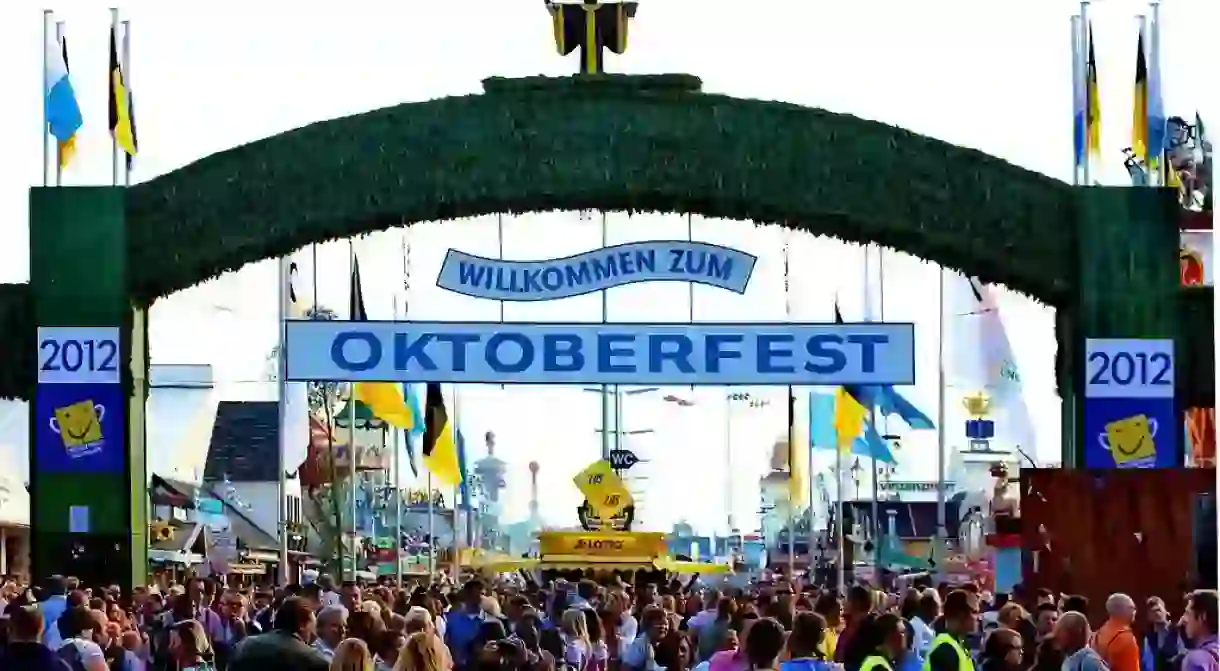The Essential Guide To Celebrating Oktoberfest

In addition to mind-boggling amounts of beer and indulgent eats, the Bavarian festival Oktoberfest offers an excellent chance to brush up on German. Munich is traditionally the location where the Oktoberfest-ivities take place, but many other spots around Germany will join in the fun. So keep those dirndls and lederhosen handy – here is everything you need to know about Oktoberfest.

Where to go
Since beginning in 1810, Oktoberfest has been held in the Bavarian capital of Munich. Usually starting on a Saturday in late September and spanning for 16-18 days, crowds gather in the thousands at Theresienwiese, which means ‘meadow of Therese,’ or the ‘Wiesn’ for short. At noon, head to the oldest beer tent, Schottenhamel, for the festival commencement ceremony where the mayor of Munich taps the first keg and yells, ‘O’zapft is!’, meaning, ‘It is tapped!’ as beer begins to flow. Also, there is the Costume and Riflemen’s Parade, which is a procession sprawling across five miles to the city center consisting of thousands of costumed dancers, marching bands, and floats.

What to drink
Okay, this one is a little obvious considering that beer is probably the first thing that comes to mind when one hears the word ‘Oktoberfest,’ but like any tradition, there is more than meets the eye. Organized around many different beer tents, including the popular Hofbräu Festzelt and the enormous Käfers Wiesen Schänke, most beers hail from one of Munich’s six famous breweries including Augustiner, Lowenbrau, Hacker Pschorr, Hofbräu, Spaten, and Paulaner. Remember, when someone calls, ‘Ein Prosit der Gemuetlichkeit!’, it means ‘drink to coziness and good cheer!’, and this is your cue to clink glasses with everyone in reach.

What to eat
Just as important as drinking your fill, feasting on Bavarian cuisine is a crucial element of these autumnal festivities. From giant pretzels and gingerbread necklaces to hendl, a slow-roasted chicken, to wurst, dumplings, and plenty else, these hearty dishes don’t disappoint, especially as the early autumnal weather begins to get chilly in the Alps. Having this robust sustenance in the belly keeps festival-goers balanced even after a liter or two of beer. For dessert, snack on some sugar-glazed almonds known as Gebrannte Mandeln, which are roasted in a copper kettle.

What to wear
Perhaps the second most notorious element of Oktoberfest are the costumes, the dirndl and the lederhosen to be precise. These costumes are modeled after traditional Bavarian dress. The ladies typically wear a dirndl, which consists of a fitted checkered dress with a bodice and apron worn over a white blouse. Lederhosen are those kitschy leather shorts or trousers with embroidered suspenders and a front cross strap. A trachten hat will complete this look. Donning one of these getups is perfectly normal at Oktoberfest, and doing so will help tourists to blend right in.

What to do
Oktoberfest is best enjoyed in good company, so be sure to grab some family or friends for this legendary event. Inside each tent, there are brass bands busting out traditional tunes along with plenty of dancing – sometimes even on the table! The ‘chicken dance’, in particular, is one of the more recent and perhaps the goofiest traditions at Oktoberfest. When it’s time to venture out of the tents to catch some fresh air, head to the Fun Fair, which is a carnival consisting of rides, snacks, live performances, games, and a Risenrad, which is a 164-foot Ferris wheel.

What music to listen to
As mentioned above, there are brass bands stationed in most of the music tents, and traditional Bavarian folk music emanates throughout. In customary Alpine style, there are polkas as well as yodeling. Sing-alongs featuring drinking songs are a common accompaniment to the beer slugging and merrymaking as well. Whether you actually understand what’s being said or not, it’s imperative to join in for the full Oktoberfest experience. Of course, we live in a globalized world, and many well-known songs have joined the ranks of Oktoberfest hymns including a variation on the Sugarhill Gang’s ‘Rapper’s Delight’ and the Village People’s ‘Y.M.C.A.’














